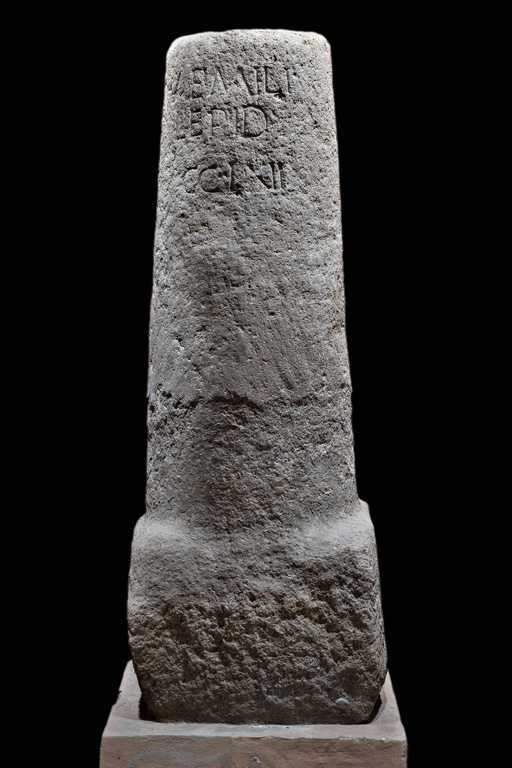
Via Emilia SS9
Un viaggio nello spazio e nel tempo, da Piacenza a Rimini e oltre, che si propone di presentare l’ieri e l’oggi della Via Emilia. Il grande ambiente si divide in un Sotto/Sopra.
Il Sotto è riferito all’esposizione dei materiali archeologici riferiti ai momenti della fondazione e utilizzazione della strada in età romana.
Alle estremità contrapposte della sala le testimonianze dei due capolinea: a est Ariminum, col riferimento all’Arco di Augusto, che corrisponde all’innesto della Via Aemilia alla Via Flaminia e l’esposizione del corredo funerario di uno dei primi coloni romani della città; a ovest Placentia, mediante i rilievi di uno spettacolare fregio d’armi che coronava un monumento funerario.
Cadenzano il percorso sette ‘espositori-teatrini’, exhibit archeologici avanzati (sette come i temi trasversali) che espongono i reperti insieme a piccole videoproiezioni che li animano e li rendono narrativi. I temi proposti sono: Limite, Ponte, Sepolture, Commercio, Foro, Locanda e Casa. Il percorso incrocia altre città attraversate dalla Via consolare, le vie trasversali, le vie d’acqua, e le loro storie rappresentate dalla sequenza dei cippi miliari in originale o in calco, delle iscrizioni e di frammenti delle pile pertinenti ai ponti della Strada consolare, delle dediche a divinità protettrici della strada e dei viandanti.
Protagoniste della grande parete le storie degli antichi romani, restituite attraverso i volti dei grandi attori protagonisti di film peplum a cui viene chiesto di interpretare storie vere tratte dalle fonti in un grande racconto che restituisce la complessa articolazione della società romana. In scena a citare storie e dar voce a personaggi, star di sceneggiati e kolossal quali Orson Welles, Kirk Douglas, Charlton Easton, Russel Crowe, Marlon Brando, Richard Burton ed Elizabeth Taylor, Peter Ustinov e Patricia Laffan, Bekim Fehmiu, Irene Papas, Peter O’Toole.
L’installazione multimediale a soffitto, con riprese effettuate al livello zero della Via Emilia di oggi, e una selezione di immagini di protagonisti della fotografia racconta invece l’attualità della strada. L’oggi diventa storia delle comunità e delle persone.
A journey through space and time from Piacenza to Rimini and beyond, that aims to show Via Emilia through the ages, from the beginning to the present day. The large space is divided between an Upper and a Lower level.
The Lower level focuses on archaeological materials that refer to the time when the road was built and used in Roman times.
Evidence of the two ends of the road is displayed at the two opposite ends of the exhibition rooms: in the East we have Ariminum, with a reference to the Arch of August, by the junction of Via Aemilia and Via Flaminia, and the display of the funerary items of one of the first Roman colonies of the city; in the West, we have Placentia, with relief fragments of a spectacular frieze of weapons that forms the top of a funerary monument.
The route is marked by seven ‘theatre-displays’, advanced archaeological exhibits (seven to match the seven transversal topics) that display the findings together with small video projections that bring them to life and tell their story. The topics proposed are: Limits, Bridge, Burials, Trade, Forum, Inns and the Home. Our journey crosses by other cities along the consular road, roads that cross over it and waterways, and their stories represented by the sequence of military memorial monuments, either the originals or copies, inscriptions and fragments of the pillars that were once part of the bridges along the consular road, and votive structures dedicated to gods who protected the road and wayfarers.
The images on the large wall tell the stories of the ancient Romans, which have been brought to life by the faces of the great actors in the “sword and sandal” films, who were called on to interpret real stories taken from the history books, in a great story that sheds light on the complexity of Roman society. Clips of stories and the voices of the personalities include great stars such as Orson Welles, Kirk Douglas, Charlton Easton, Russel Crow, Marlon Brando, Richard Burton and Elizabeth Taylor, Peter Ustinov and Patricia Laffan, Bekim Fehmiu, Irene Papas and Peter O’Toole.
The multimedia display on the ceiling shows clips taken of the ground zero of the present-day Via Emilia, while a series of images taken by star photographers gives an idea of the road as it stands today. The present becomes a story of the community and its people.
Il racconto:
Caio Metellio Costante, l’agrimensore
Non devo affrontare il nemico in battaglia, nè avanzare tenendo saldo tra le mie mani il vessillo di guerra, ma il mio compito non è meno importante: in qualità di ufficiale del genio ho il duro compito e la responsabilità di approntare l’accampamento dell’esercito, il vanto della tecnica militare romana, che desta al contempo stupore e timore tra i popoli ostili. La perfetta organizzazione del campo, le sue imponenti opere di difesa, la razionale disposizione degli acquartieramenti, devono essere realizzati in breve tempo su ogni tipo di terreno, sotto il sole cocente o sotto lo sferzare della tempesta, spesso di fronte alla minaccia di un attacco improvviso. Qui, nell’accampamento, sta la vera forza del nostro esercito, qui la sua sicurezza.
Nella foto: Cippo miliario della via Emilia da Castel San Pietro Terme; Bologna, Museo Civico Archeologico (foto: Carlo Vannini)
I TEMI DELLA MOSTRA
